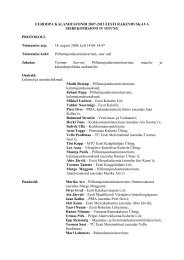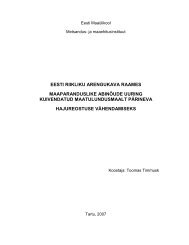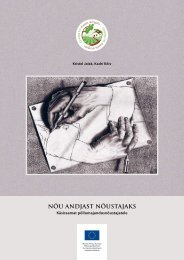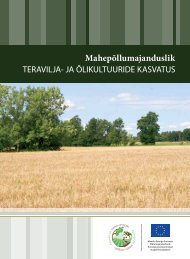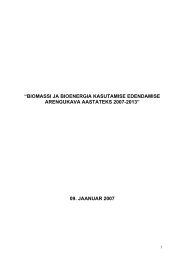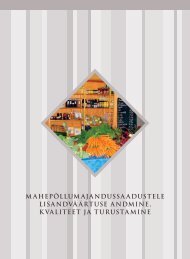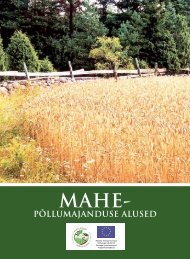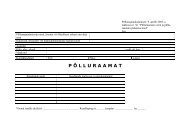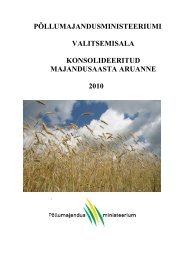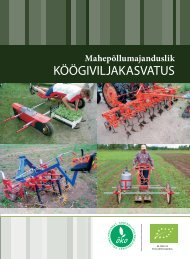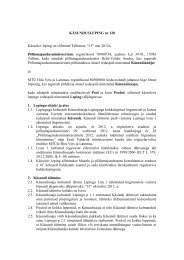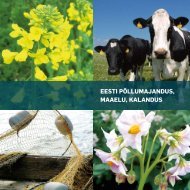estonian agriculture, rural economy and food industry
estonian agriculture, rural economy and food industry
estonian agriculture, rural economy and food industry
You also want an ePaper? Increase the reach of your titles
YUMPU automatically turns print PDFs into web optimized ePapers that Google loves.
2.<br />
Changes in <strong>agriculture</strong> after Estonia<br />
re-gained independence<br />
During the 20 th century, Estonia experienced<br />
three significant political transformations, the<br />
conflicting objectives of which had dramatic<br />
impact on its agricultural activity:<br />
In the 1920s, former manor l<strong>and</strong>s were sold to<br />
farmers as Estonia became independent for the first<br />
time in history. Estonian <strong>agriculture</strong> began to<br />
develop rapidly <strong>and</strong> Estonia became a considerable<br />
agricultural producer in Europe.<br />
At the end of the 1940s, forced collectivisation<br />
was carried out in Estonia under the conditions of<br />
Soviet occupation; l<strong>and</strong> was expropriated from its<br />
owners <strong>and</strong> made public, <strong>and</strong> farmers were forced<br />
to work on collective farms.<br />
At the end of the 1980s, as Estonia re-gains independence,<br />
l<strong>and</strong> that was unlawfully expropriated<br />
during the Soviet occupation is returned to the lawful<br />
owners. Farms are restored <strong>and</strong> larger agricultural<br />
enterprises emerge as the result of the buying <strong>and</strong><br />
leasing of the privatised property of collective farms.<br />
In 1988, even before Estonia regained its independence,<br />
the Estonian SSR government adopted an<br />
unprecedented decision to permit the re-establishment<br />
of farms <strong>and</strong> enable the selling of machinery,<br />
equipment, <strong>and</strong> vehicles to farmers.<br />
The Farm Act was adopted in 1989 to provide<br />
legal guarantees for the establishment <strong>and</strong> development<br />
of farms.<br />
The L<strong>and</strong> Reform Act was adopted in 1991.<br />
Under this Act, l<strong>and</strong> was returned to the lawful<br />
owners <strong>and</strong> it was possible to privatise l<strong>and</strong> by<br />
pre-emptive rights or on general grounds. People<br />
whose buildings were located on l<strong>and</strong> subject to<br />
privatisation were entitled to pre-emptive rights.<br />
Since 1996 the restitution <strong>and</strong> privatisation of<br />
l<strong>and</strong> has intensified. By the end of 2001, 860,000<br />
ha, or 71% of the agricultural l<strong>and</strong> stock <strong>and</strong><br />
1.5 million ha of forest l<strong>and</strong> had been entered into<br />
the l<strong>and</strong> register. L<strong>and</strong> reform is expected to be<br />
finalised by 2003.<br />
The Agricultural Reform Act was adopted in<br />
1992. This Act established the grounds for the<br />
liquidation of collective farms <strong>and</strong> the establishment<br />
of new farms <strong>and</strong> agricultural enterprises –<br />
private <strong>and</strong> public limited companies – on the basis<br />
of their assets <strong>and</strong> l<strong>and</strong>.<br />
The assets of 360 previously collective farms<br />
were used to establish 11,700 commercial farms<br />
<strong>and</strong> 709 agricultural enterprises.<br />
Relative share of <strong>agriculture</strong><br />
has decreased<br />
As a result of reforms, the relative share of <strong>agriculture</strong><br />
in the gross domestic product decreased<br />
from 15% to 3.3% during 1991–2000, while<br />
employment in <strong>agriculture</strong> decreased from 15% to<br />
5.2%. Due to structural changes, the employment of<br />
TABLE 1.<br />
Agriculture in the national <strong>economy</strong><br />
1992 1993 1996 1997 1998 1999 2000<br />
Share of <strong>agriculture</strong> <strong>and</strong> hunting<br />
in GDP (millions of kroons,<br />
current prices)<br />
1665,9*<br />
2123,1*<br />
2722,6<br />
2779,5<br />
2810,0<br />
2584,2<br />
2784,1<br />
Relative share in GDP (%)<br />
11,7<br />
9,3<br />
5,2<br />
4,3<br />
4,3<br />
3,7<br />
3,6<br />
Employment in <strong>agriculture</strong> <strong>and</strong><br />
hunting (‘000)<br />
114,6<br />
91,9<br />
52,1<br />
44,8<br />
43,5<br />
38,2<br />
31,5<br />
Employment %<br />
15,0<br />
13,0<br />
8,1<br />
6,9<br />
6,8<br />
6,2<br />
5,2<br />
Export of agricultural products<br />
(millions of kroons)<br />
973,5<br />
2498,6<br />
3227,6<br />
3391,3<br />
3476,9<br />
2589,9<br />
3093,6<br />
Relative share of export of<br />
agricultural products (%)<br />
17,5<br />
23,5<br />
15,2<br />
11,5<br />
9,9<br />
7,5<br />
5,8<br />
* including forestry<br />
(Source: Estonian Statistical Office (ESO))<br />
8



